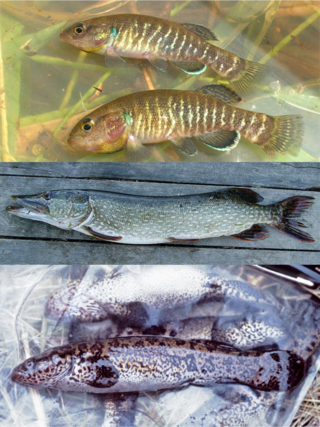
Esocidae is a family of fish in the order Esociformes, which contains pike, pickerel, and mudminnows. While the family traditionally only contained the genus Esox, recent genetic and paleontological research have recovered Novumbra and Dallia as members of the family Esocidae, being closer related to Esox than Umbra. Fossil specimens from the Mesozoic in North America have been assigned as two additional genera in this family.

The Esociformes is a small order of freshwater ray-finned fish, with two families, Umbridae and Esocidae. The pikes of genus Esox give the order its name.

The American horned owls and the Old World eagle-owls make up the genus Bubo, at least as traditionally described. The genus name Bubo is Latin for owl.
Lampriformes is an order of ray-finned fish. Members are collectively called lamprids or lampriforms, and unite such open-ocean and partially deep-sea Teleostei as the crestfishes, oarfish, opahs, and ribbonfishes. A synonym for this order is Allotriognathi, while an often-seen, but apparently incorrect, spelling variant is Lampridiformes. They contain seven extant families which are generally small but highly distinct, and a mere 12 lampriform genera with some 20 species altogether are recognized.
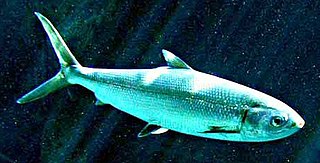
The Gonorynchiformes are an order of ray-finned fish that includes the important food source, the milkfish, and a number of lesser-known types, both marine and freshwater.
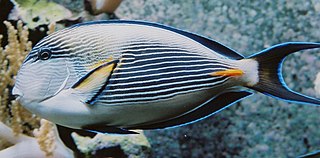
Acanthuridae are the family of surgeonfishes, tangs, and unicornfishes. The family includes about 86 extant species of marine fish living in tropical seas, usually around coral reefs. Many of the species are brightly colored and popular in aquaria.
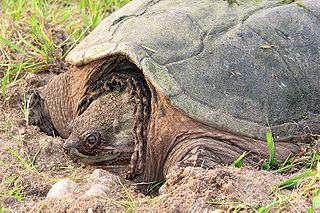
The Chelydridae is a family of turtles that has seven extinct and two extant genera. The extant genera are the snapping turtles, Chelydra and Macrochelys. Both are endemic to the Western Hemisphere. The extinct genera are Acherontemys, Chelydrops, Chelydropsis, Emarginachelys, Macrocephalochelys, Planiplastron, and Protochelydra.

Paraceratherium is an extinct genus of hornless rhinocerotoids belonging to the family Paraceratheriidae. It is one of the largest terrestrial mammals that has ever existed and lived from the early to late Oligocene epoch. The first fossils were discovered in what is now Pakistan, and remains have been found across Eurasia between China and the Balkans. Paraceratherium means "near the hornless beast", in reference to Aceratherium, the genus in which the type species P. bugtiense was originally placed.

Sisoridae is a family of catfishes. These Asian catfishes live in fast-moving waters and often have adaptations that allow them to adhere to objects in their habitats. The family includes about 235 species.

Umbridae is a family of fish in the order Esociformes, which contains pike, pickerel, and mudminnows. The single living genus, Umbra, occupies weed-choked freshwater habitats in eastern North America and eastern Europe. While the family traditionally contained the genera Umbra, Novumbra, and Dallia, recent genetic and paleontological research have recovered this grouping as paraphyletic, with Novumbra and Dallia being moved to the family Esocidae.
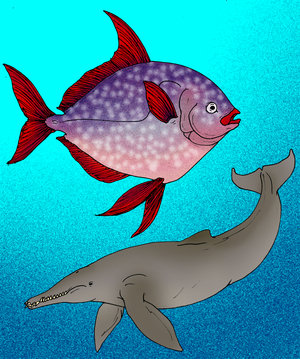
Megalampris keyesi is an extinct opah from the late Oligocene of New Zealand about 26 million years ago. It was recovered from the Otekaike Limestone in North Otago, by a team led by Ewan Fordyce from the Geology Department of the University of Otago. The species is named in honour of the New Zealand palaeontologist Ian Warwick Keyes (1938-2004). It is the largest fossil teleost fish from New Zealand, the spectacular remains comprise three large limestone blocks containing mostly caudal skeleton. These are on display in the Otago Museum, Dunedin, New Zealand. Some of the vertebral centra preserved are 90 mm across. Comparison with the skeletons of living Lampris species suggest the giant fish was around 4 metres (13 ft) in length when alive, which is twice the length of the largest living opah species, Lampris guttatus. The cleithra in the fossil are significantly enlarged to suggest that Megalampris used the pectoral swimming mode characteristic of moonfishes.
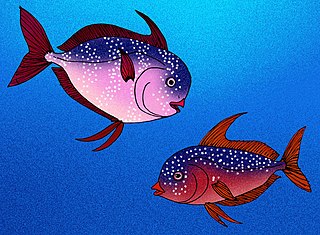
Turkmenidae is an extinct family of lamprids from the Paleogene of Turkmenistan. They were small, disk-shaped fish that bore a strong resemblance to their closest living relatives, the opahs.

Caranx is a genus of tropical to subtropical marine fishes in the jack family Carangidae, commonly known as jacks, trevallies and kingfishes. They are moderate- to large-sized, deep-bodied fishes which are distinguished from other carangid genera by specific gill raker, fin ray and dentition characteristics. The genus is represented in the Pacific, Indian and Atlantic Oceans, inhabiting both inshore and offshore regions, ranging from estuaries and bays to deep reefs and offshore islands. All species are powerful predators, taking a variety of fish, crustaceans and cephalopods, while they in turn are prey to larger pelagic fishes and sharks. A number of fish in the genus have a reputation as powerful gamefish and are highly sought by anglers. They often make up high amounts of the catch in various fisheries, but are generally considered poor to fair table fishes.
Oligolophotes is an extinct genus of fish from the Early Oligocene of the bank of Belaya River in Adygea, the Caucasus Mountains. There is one species, Oligolophotes fragosus, known from the holotype that is estimated to have measured 122 mm (4.8 in) in body length.

Araripichthys is an extinct genus of ray-finned fish that lived from the Aptian to Coniacian stages of the Cretaceous period. The genus is named after the Araripe Basin, where it was found in the Crato and Santana Formations. Other fossils of the genus have been found at Goulmima in Morocco, the Tlayua Formation of Mexico and the Apón Formation of Venezuela.

Eumecichthys fiski, the unicorn crestfish or unicornfish, is a very rare, little-known species of crestfish in the family Lophotidae, and the only member of the genus Eumecichthys. It likely has a worldwide distribution, having been first discovered offshore of Kalk Bay, South Africa, and subsequently reported from the Sea of Japan, southwest Florida, Clarion Island off Mexico, Hawaii, and India. A report from the Bering Sea may have been in error. It is found in the bathypelagic zone, at a depth of around 1,000 m (3,300 ft).
The Moreno Formation is a Mesozoic geologic formation located in San Joaquin Valley (California).
Dinosaur remains diagnostic to the genus level are among the fossils that have been recovered from the formation.

Loaches are fish of the superfamily Cobitoidea. They are freshwater, benthic (bottom-dwelling) fish found in rivers and creeks throughout Eurasia and northern Africa. Loaches are among the most diverse groups of fish; the 1249 known species of Cobitoidea comprise about 107 genera divided among 9 families.
This list of fossil fishes described in 2014 is a list of new taxa of placoderms, fossil cartilaginous fishes and bony fishess of every kind that have been described during the year 2014, as well as other significant discoveries and events related to paleontology of fishes that occurred in the year 2014. The list only includes taxa at the level of genus or species.
This list of fossil fishes described in 2017 is a list of new taxa of jawless vertebrates, placoderms, acanthodians, fossil cartilaginous fishes, bony fishes and other fishes of every kind that are scheduled to be described during the year 2017, as well as other significant discoveries and events related to paleontology of fishes that are scheduled to occur in the year 2017. The list only includes taxa at the level of genus or species.















